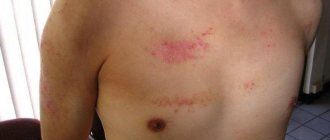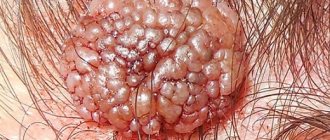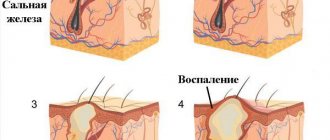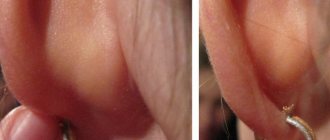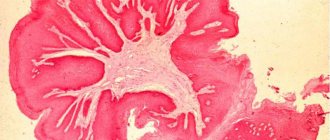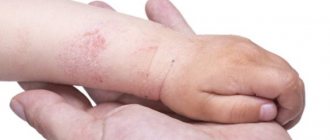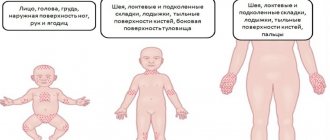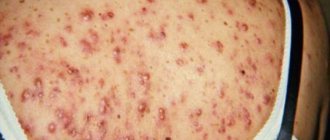Atheroma on the head (epidermal cyst) is a benign formation that forms due to blockage of the tubules of the sebaceous glands. Externally, atheroma of the scalp resembles a lump with clear boundaries and slight mobility, but inside it is filled with adipose tissue. Such a cyst can appear on any part of the body, but most often it forms in the scalp due to the abundance of sebaceous glands in it.
Pathology is diagnosed in men and women. In addition, a fairly common occurrence is the appearance of such a cyst on a child’s head. As a rule, it affects infants, in whom it most often goes away on its own. As for adults, they often perceive education as a cosmetic defect that brings significant psychological discomfort.
Why does atheroma occur?
Thanks to numerous studies, it has been found that most often atheroma is formed due to physical damage to the sebaceous gland or its ducts.
At the same time, the gland continues to produce fluid, but since it cannot reach the surface of the skin, atheroma is formed. Infection is also possible, and then you need to urgently contact the surgical service for help.
- Injury to the skin and the sebaceous glands directly;
- Being in toxic environmental conditions or working in a hazardous enterprise;
- Serious metabolic and metabolic disorders;
- Imbalance of the hormonal system.
All these factors can cause the formation of a neoplasm, and the causes of atheroma on the head are similar in both women and men.
Causes
Atheroma can appear for several reasons. The most important of them is problems with the passage of sebum. If the duct of the sebaceous gland is blocked, then sebum is produced directly under the skin, in a special capsule, where the blockage of the sebaceous gland cyst occurs. Compaction also occurs when the hair follicle swells, which is damaged as a result of various microtraumas. If, after pulling out the hair, the exit from the pouch is blocked, the follicle also begins to fill with fatty contents. The process is aggravated by increased production of testosterone in the body, as sebum production increases. The disease can be triggered by various types of injuries and damage to the sebaceous glands themselves.
As a result of the pathological process, a boil or carbuncle may form, and a wen appears against the background. The wen capsule contains a product produced by the sebaceous glands; in appearance it resembles a white pasty mass. When pathogenic bacteria penetrate inside, it becomes inflamed.
Suppurating atheroma acquires a different yellow color depending on the severity of the pathological process. Sometimes atheroma takes on a pink-brown color if there is blood in it. The appearance of atheroma can occur in people of both sexes - both men and women suffer from the disease.
Occasionally, pathology can be noticed even in a child. Most often, extensive atheromatosis is recorded in men. Clogging of the sebaceous glands begins during puberty and worsens in adulthood, when atheromas become large.
Source: facey.ru
Types of atheroma
There are only 2 types of neoplasms:
- Acquired atheroma. Statistics show that the disease can develop at any age of a person;
- Congenital atheroma. Most often it forms on the child’s head and often does not increase over the course of several months to several years.
Also, atheroma can be either single or multiple, located in different parts of the body.
Prevention
If the tumor is congenital, its appearance cannot be prevented. In other cases, it is necessary to follow medical recommendations that will reduce the risk of developing pathology:
Visit your pediatrician regularly.
- For your child’s personal hygiene, use high-quality cosmetics that will reduce the secretion of subcutaneous fat;
- buy clothes only from natural materials. Make sure that it does not squeeze the skin;
- do not overheat the baby. Excessive sweating causes blockage of the ducts;
- examine the child’s body to identify a lump at an early stage;
- Regularly visit your pediatrician, who can determine the presence of pathology.
Atheroma in children rarely poses a serious danger to life or health. The exception is when the tumor is infected or pus has accumulated inside. Also dangerous are those cystic formations that are located in the head area, since there is a threat of infection entering the brain. To reduce the risk of developing a wen, you need to follow the rules of personal hygiene and promptly visit your doctor.
How does atheroma occur?
Despite the fact that a tumor can occur in any part of the hairline, most often atheroma forms on a person’s head, since it is in this place that the sebaceous glands produce secretions most intensively.
Over time, when the secretion accumulates, the formation increases in size and does not cause pain in humans.
At the site of the sebaceous duct, a secretion accumulates, which is limited from the surrounding tissues by a capsule. Has slight mobility when pressed.
What is inside the atheroma
In the normal course of the disease, inside the formation there is a thick mass of gray-yellow color. When analyzing the contents under a microscope, you can find particles of squamous epithelium, fat, skin and tissue.
If an infection penetrates inside, the contents of the atheroma acquire a brown tint, which indicates an active inflammatory process.
Symptomatic picture
In a normal course, when there is no infection by microorganisms, the formation does not bother the person in any way. Upon careful examination, a yellow-pink color will be visible, but when pressed, a person will not feel anything.
When the color of the atheroma changes to dark red or brown, the formation will be accompanied by symptoms such as pain, inflammation of the tissue around the formation, and also if there is a large amount of pus inside the tissue, the tissue may not be able to withstand, so some of the contents come out.
Symptoms of the disease
The disease can be diagnosed by palpation. The formation has a soft, rounded structure. The skin over the cyst is slightly darker than the rest of the skin. And when infected, an abscess occurs: the skin turns red, swelling and pain appear.
Sometimes there is a leakage of pus from the capsule. This disease is characterized by features of a lipoma and cerebral hernia. Therefore, a thorough examination and then treatment is required.
Diagnostics
Doctors do not recommend palpating the tumor on their own, since if there is a large accumulation of pus, pressing with excessive force can lead to rupture of the capsule and the contents will be evacuated into neighboring tissues, and not out.
In some cases, ultrasound examination is used, but most often, due to obvious symptoms, instrumental research methods are not required and the doctor begins treatment.
Treatment
How to get rid of atheroma on the scalp? This can only be treated by removal. Otherwise, after opening the capsule, infection may occur, which will lead to the formation of a cyst, abscess or abscess.
The neoplasm is first opened, and then the tissue captured by inflammation is removed. The surgical intervention is performed under local anesthesia and at the end of the procedure sutures are applied to prevent recurrence of the disease.
The danger of atheroma on the head and methods for removing the formation do not in any way affect the general well-being of a person. The only thing that must be done is to apply a pressure bandage to the operation site to prevent bleeding and infection of the wound.
Folk remedies
Peony root decoction.
You should take 2 tbsp at home. spoons of finely chopped peony roots and pour 500 ml. water, boil. Next, strain and let cool. Wipe the problem area of skin with the decoction. Spring primrose. Take 1 tbsp. spoon of dry spring primrose herb and pour 0.2 liters. water, boil. Then let it cool, strain and add the broth while taking a bath.
Baked onion and soap ointment
You should bake a medium-sized onion in the oven and grind it in a meat grinder. Add 1 tbsp to the resulting slurry. spoon of grated laundry soap, mix. Apply the resulting ointment to the desired location and tie it with a scarf. Change the ointment 2-3 times a day until the disease disappears completely.
Burdock root
An excellent folk remedy for the treatment of atheroma. You need to take burdock root and mix it with the same amount of pork fat or natural butter. Infuse the mixture for 3 days. Next, squeeze out using gauze. The ointment is fixed with a bandage for three days. During this time, the contents of the tumor will come out.
Chicken egg film
Carefully separate the egg film and apply it to the sore spot. After a few hours, swelling and redness may occur, but you should not be afraid of this - this is normal. After the swelling disappears, the treatment is duplicated. Most often, 2-3 such procedures at home are enough.
Treatment of atheroma behind the ear
You will need to peel half the garlic and chop it thoroughly. Then mix the resulting composition with 2 tablespoons of pure sunflower oil. The prepared product must be rubbed into the diseased atheroma every day at least 2-3 times.
Healing atheroma of the earlobe
Mix 2 tablespoons of ammonia with the same amount of boiled water. Well moisten a piece of a necessarily sterile bandage in the composition and carefully apply it as a lotion for 5-7 minutes daily to the atheroma lesion. Then remove the compress and lightly rinse the atheroma with boiled warm water.
Lamb fat
A very effective folk remedy in the treatment of atheroma. Many traditional medicine healers often recommend the use of lamb fat for many ailments. They also say that this is the most effective remedy. To do this, you need to melt this fat a little over low heat, and then gently rub it up to five times a day into the places where atheroma has formed.
Medicinal wheat germ juice
Very useful for improving the general condition of the human body. As a rule, there are no special restrictions on the use of this product, but it is recommended to consume this juice every day. It significantly improves the metabolism of essential substances, including normalizing the functioning of the sebaceous glands.
Coltsfoot
A decoction prepared at home from fresh leaves of the coltsfoot plant is also considered a very effective and efficient remedy for getting rid of such an ailment. Just boil a small amount of leaves in water and then you can drink the prepared drink in small half of one glass once daily.
Vishnevsky ointment
It is no secret that this ointment is used for various harmful ailments. But it is also capable of defeating atheroma. To do this, you need to apply the ointment daily for a long time, it is advisable to keep it this way until you notice the appearance of a small hole from which the dirty contents of the sore begin to emerge.
Source: sovetcik.ru
Types of surgery
Currently, not only standard surgical intervention with a scalpel is used, but also radio wave and laser removal of atheroma.
When a patient consults a doctor and makes a diagnosis, the doctor discusses all the risks and progress of the procedure, and also decides how best to remove the atheroma on the head, so that the patient takes an active part in making decisions and further treatment of the tumor.
Features of the procedure
It is not recommended to eat or drink 3-4 hours before the procedure to avoid aspiration of vomit, for example, in case of an allergic reaction to drugs used for anesthesia. Also, if possible, the procedure can be postponed until colder weather arrives, since in hot weather the risk of infection of the postoperative wound and the development of complications increases.
After the procedure, the doctor tells the patient what needs to be done after removing the atheroma, when you can wash your hair and how to protect yourself from the formation of such tumors. But in any case, washing your hair is strictly prohibited until the stitches are removed and the wound has completely healed. Because the risk of wound contamination by microorganisms increases to 95%.
The danger of newborn babies
Atheroma itself in children is not dangerous.
In addition, its asymptomatic development does not cause sensitive problems for the baby. And if the tumor is not inflamed, it does not threaten the child with any consequences. But for newborn babies, surgical removal will be problematic due to the need for anesthesia and antibiotics, which has a negative impact on the child’s body. Therefore, surgeons try, if possible, to delay the removal of atheromas in infants. The article has been verified by the editors

